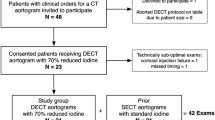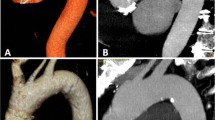Abstract
Objectives
To evaluate CT aortography at reduced tube voltage and contrast medium dose while maintaining image quality through iterative reconstruction (IR).
Methods
The Institutional Review Board approved a prospective study of 48 patients who underwent follow-up CT aortography. We performed intra-individual comparisons of arterial phase images using 120 kVp (standard tube voltage) and 80 kVp (low tube voltage). Low-tube-voltage imaging was performed on a 320-detector CT with IR following injection of 40 ml of contrast medium. We assessed aortic attenuation, aortic attenuation gradient, image noise, contrast-to-noise ratio (CNR), volume CT dose index (CTDIvol), and figure of merit (FOM) of image noise and CNR. Two readers assessed images for diagnostic quality, image noise, and artefacts.
Results
The low-tube-voltage protocol showed 23–31 % higher mean aortic attenuation and image noise (both P < 0.01) than the standard-tube-voltage protocol, but no significant difference in the CNR and aortic attenuation gradients. The low-tube-voltage protocol showed a 48 % reduction in CTDIvol and an 80 % increase in FOM of CNR. Subjective diagnostic quality was similar for both protocols, but low-tube-voltage images showed greater image noise (P = 0.01).
Conclusions
Application of IR to an 80-kVp CT aortography protocol allows radiation dose and contrast medium reduction without affecting image quality.
Key Points
• CT aortography at 80 kVp allows a significant reduction in radiation dose.
• Addition of iterative reconstruction reduces image noise and improves image quality.
• The injected contrast medium dose can be substantially reduced at 80 kVp.
• Aortic enhancement is uniform despite a reduced volume of contrast medium.




Similar content being viewed by others
Abbreviations
- AIDR:
-
adaptive iterative dose reduction
- CNR:
-
contrast-to-noise ratio
- CTA:
-
computed tomography angiography
- ED:
-
effective dose
- EVAR:
-
endovascular aortic repair
- FBP:
-
filtered-back projection
- FOM:
-
figure of merit
- IR:
-
iterative reconstruction
- ROI:
-
region of interest
- PACS:
-
picture-archiving and communication system
References
Nakayama Y, Awai K, Funama Y et al (2005) Abdominal CT with low tube voltage: preliminary observations about radiation dose, contrast enhancement, image quality, and noise. Radiology 237:945–951
Sigal-Cinqualbre AB, Hennequin R, Abada HT, Chen X, Paul JF (2004) Low-kilovoltage multi-detector row chest CT in adults: feasibility and effect on image quality and iodine dose. Radiology 231:169–174
Kalra MK, Maher MM, Toth TL et al (2004) Techniques and applications of automatic tube current modulation for CT. Radiology 233:649–657
Dewey M, Zimmermann E, Deissenrieder F et al (2009) Noninvasive coronary angiography by 320-row computed tomography with lower radiation exposure and maintained diagnostic accuracy: comparison of results with cardiac catheterization in a head-to-head pilot investigation. Circulation 120:867–875
Leipsic J, Nguyen G, Brown J, Sin D, Mayo JR (2010) A prospective evaluation of dose reduction and image quality in chest CT using adaptive statistical iterative reconstruction. AJR Am J Roentgenol 195:1095–1099
Huda W, Scalzetti EM, Levin G (2000) Technique factors and image quality as functions of patient weight at abdominal CT. Radiology 217:430–435
Kooiman J, Pasha SM, Zondag W et al (2012) Meta-analysis: serum creatinine changes following contrast enhanced CT imaging. Eur J Radiol 81:2554–2561
Marin D, Nelson RC, Schindera ST et al (2010) Low-tube-voltage, high-tube-current multidetector abdominal CT: improved image quality and decreased radiation dose with adaptive statistical iterative reconstruction algorithm—initial clinical experience. Radiology 254:145–153
Goshima S, Kanematsu M, Nishibori H et al (2011) CT of the pancreas: comparison of anatomic structure depiction, image quality, and radiation exposure between 320-detector volumetric images and 64-detector helical images. Radiology 260:139–147
Gervaise A, Osemont B, Lecocq S et al (2012) CT image quality improvement using Adaptive Iterative Dose Reduction with wide-volume acquisition on 320-detector CT. Eur Radiol 22:295–301
Nakayama Y, Awai K, Funama Y et al (2006) Lower tube voltage reduces contrast material and radiation doses on 16-MDCT aortography. AJR Am J Roentgenol 187:W490–W497
Schindera ST, Graca P, Patak MA et al (2009) Thoracoabdominal-aortoiliac multidetector-row CT angiography at 80 and 100 kVp: assessment of image quality and radiation dose. Invest Radiol 44:650–655
Szucs-Farkas Z, Kurmann L, Strautz T, Patak MA, Vock P, Schindera ST (2008) Patient exposure and image quality of low-dose pulmonary computed tomography angiography: comparison of 100- and 80-kVp protocols. Invest Radiol 43:871–876
Paul NS, Blobel J, Prezelj E et al (2010) The reduction of image noise and streak artifact in the thoracic inlet during low dose and ultra-low dose thoracic CT. Phys Med Biol 55:1363–1380
Huda W, Magill D, He W (2011) CT effective dose per dose length product using ICRP 103 weighting factors. Med Phys 38:1261–1265
ICRP (2007) The 2007 Recommendations of the International Commission on Radiological Protection. ICRP publication 103. Ann ICRP 37:1–332
Schoellnast H, Tillich M, Deutschmann MJ, Deutschmann HA, Schaffler GJ, Portugaller HR (2004) Aortoiliac enhancement during computed tomography angiography with reduced contrast material dose and saline solution flush: influence on magnitude and uniformity of the contrast column. Invest Radiol 39:20–26
Brooks RA, Di Chiro G (1976) Statistical limitations in x-ray reconstructive tomography. Med Phys 3:237–240
Bae KT (2010) Intravenous contrast medium administration and scan timing at CT: considerations and approaches. Radiology 256:32–61
Kim DJ, Kim TH, Kim SJ et al (2008) Saline flush effect for enhancement of aorta and coronary arteries at multidetector CT coronary angiography. Radiology 246:110–115
Wintersperger B, Jakobs T, Herzog P et al (2005) Aorto-iliac multidetector-row CT angiography with low kV settings: improved vessel enhancement and simultaneous reduction of radiation dose. Eur Radiol 15:334–341
Prakash P, Kalra MK, Kambadakone AK et al (2010) Reducing abdominal CT radiation dose with adaptive statistical iterative reconstruction technique. Invest Radiol 45:202–210
Sagara Y, Hara AK, Pavlicek W, Silva AC, Paden RG, Wu Q (2010) Abdominal CT: comparison of low-dose CT with adaptive statistical iterative reconstruction and routine-dose CT with filtered back projection in 53 patients. AJR Am J Roentgenol 195:713–719
Singh S, Kalra MK, Hsieh J et al (2010) Abdominal CT: comparison of adaptive statistical iterative and filtered back projection reconstruction techniques. Radiology 257:373–383
Tatsugami F, Matsuki M, Nakai G et al (2012) The effect of adaptive iterative dose reduction on image quality in 320-detector row CT coronary angiography. Br J Radiol 85:e378–e382
Watanabe H, Kanematsu M, Miyoshi T et al (2010) Improvement of image quality of low radiation dose abdominal CT by increasing contrast enhancement. AJR Am J Roentgenol 195:986–992
Iezzi R, Cotroneo AR, Giammarino A, Spigonardo F, Storto ML (2011) Low-dose multidetector-row CT-angiography of abdominal aortic aneurysm after endovascular repair. Eur J Radiol 79:21–28
Bae KT, Heiken JP, Brink JA (1998) Aortic and hepatic peak enhancement at CT: effect of contrast medium injection rate—pharmacokinetic analysis and experimental porcine model. Radiology 206:455–464
Awai K, Hori S (2003) Effect of contrast injection protocol with dose tailored to patient weight and fixed injection duration on aortic and hepatic enhancement at multidetector-row helical CT. Eur Radiol 13:2155–2160
Acknowledgments
This study was supported by a grant from the Chang Gung Medical Research Program (CMRPG1B0061). We acknowledge the assistance of the dedicated radiology staff at Chang Gung Memorial Hospital Linkou.
Author information
Authors and Affiliations
Corresponding author
Rights and permissions
About this article
Cite this article
Chen, CM., Chu, SY., Hsu, MY. et al. Low-tube-voltage (80 kVp) CT aortography using 320-row volume CT with adaptive iterative reconstruction: lower contrast medium and radiation dose. Eur Radiol 24, 460–468 (2014). https://doi.org/10.1007/s00330-013-3027-3
Received:
Revised:
Accepted:
Published:
Issue Date:
DOI: https://doi.org/10.1007/s00330-013-3027-3




